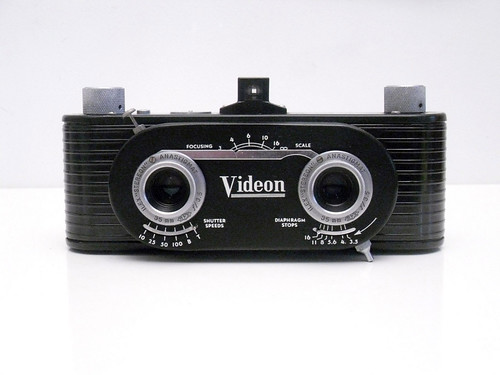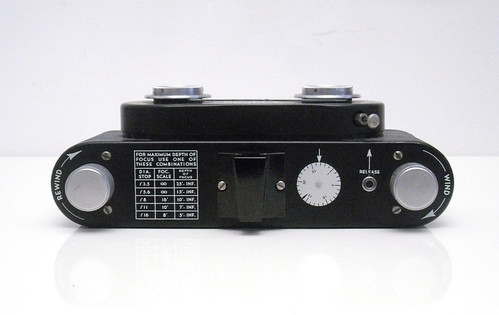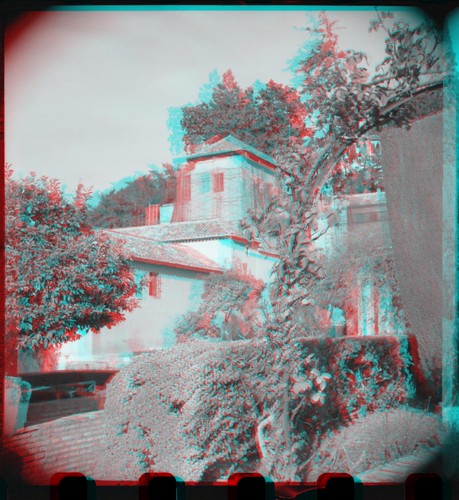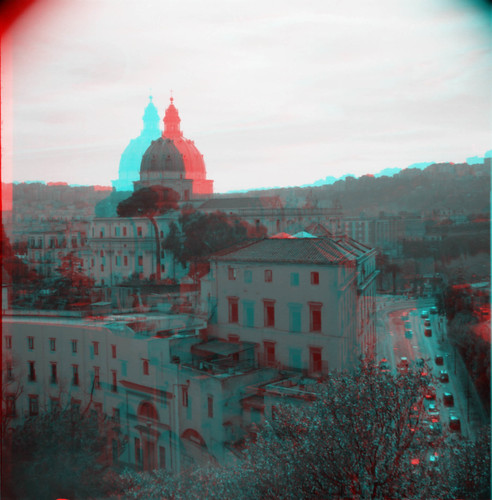 |
| Sterocrafters Videon 35mm stereo camera |
I first became interested in stereo photography about ten years ago when I bought a couple of stereo cameras, the fairly well known
Sputnik, a medium format camera, and this, the
Videon, a 35mm camera. I don't have the camera any more, but I thought it might be worth writing it up in a blog post as there is relatively little about the Videon on the net (and much that is on the net isn't necessarily in English). I bought the camera, with a case, from a secondhand camera shop, before these were effectively wiped out by auction sites.
Stereo or stereoscopic photography is simply the means of taking pictures that replicate binocular vision, that is the impression of three dimensions achieved by combining the vision from two eyes which see from slightly different viewpoints (it is sometimes, inaccurately, referred to as '3D photography'). The easiest way to replicate this in photography is to have a camera with two lenses, roughly the same distance apart as human eyes, which take two photographs simultaneously. The two photographs then have to be viewed in such a way that the right eye only sees the right side image, and the left eye the left one. Stereo photography was invented just a few years after photography itself, and has experienced periods of popularity since. There was a post-war boom in 35mm stereo photography, from which the Videon dates (1953, according to Massimo Bertacchi's
Innovative Camera site). It was made by Stereocrafters of
Wisconsin; apart from a Videon II, it appears the company made no other models.
The Videon is simply and cheaply constructed. The body is moulded in two halves from bakelite, with pressed or stamped metal top and bottom plates, and the lenses and shutters housed in a metal surround. The lenses are Ilex "Stereon" f3.5 35mm anastigmats; the shutters are un-named, but perhaps also by Ilex, with a limited range of speeds, 1/100, 1/50, 1/25, 1/10 sec., and 'B' and 'T' settings. These are set by rotating a pin, one under each lens. Framing is by a simple viewfinder on the top plate, equidistant between the two lenses. Focus is manual by turning one or the other of the lenses, with a metal arm joining the two, and a V-shaped notch that indicates the focus on the scale.
The Videon takes 35mm film, loaded by
sliding off the back and bottom plate. However, the image format, like most 35mm stereo cameras, is a non-standard size, c.24x25mm. After loading the frame counter is set manually; this goes up to 25, which are stereo
pairs, i.e. 25 pairs of photographs. The counter is a simple rotating disc directly on the top plate, with nothing to stop it being accidentally turned, meaning it's very easy to lose one's place on the film. There is a release button next to the frame counter, which needs to be pushed forwards before the film is wound on - and also when rewinding the film.
 |
Videon top plate, showing from left: rewind knob; depth of focus scale; viewfinder;
frame counter; wind release (shutter release above this); wind on knob. |
As the scan below shows, the Videon frame advance winds the film after each exposure to take three pairs in a row, then has to wind on past the second set of three frames so as not to double expose them, and then take another three pairs of exposures. The image below also shows how narrow the image circles of the lenses are, leading to heavy (and uneven) vignetting in the corners. The exposures also overlap a little on the film at the edges. I imagine in practice the stereo pairs would be cropped down to avoid these flaws showing in the final prints. In practice, the brass sprockets in the camera easily tore the sprocket holes on the film, leading the film to frequently slip, and part-double exposures were not uncommon. Damage to the sprocket holes can be seen to the right hand side of the strip.
 |
| The stereo pair are the two outermost frames of the four pictures. |
When I bought the Videon, I didn't have access to a darkroom, so generally used chromogenic black and white film, and had it developed and a contact sheet made, which I then scanned. I have recently scanned some of the negatives directly, which makes for better image quality. To view the images I convert the stereo pairs into anaglyphs, requiring red-green glasses for viewing.
 |
| Generalife, Alhambra, Spain - anaglyph from the pair on the strip above. |
The anaglyphs are created in Photoshop, by selecting the red channel in the Channels palette (in RGB mode), then selecting the right hand of the stereo pair and moving it until it sits over the left hand image, and then cropping the whole. This does create a red-cyan image rather than red-green, but it works sufficiently well. This technique can also be used with colour images, but with less success perhaps.
 |
| Botanical Garden, Potsdam |
Overall, I found the Videon to be less than reliable as a camera, mostly due to the winding on mechanism: when relying on taking two pictures at a time, frequently one half of a stereo pair would be partly obscured by a double exposure occurring, thus rendering the pair unusable for stereo purposes. However, compared to the Sputnik camera I've still got, it had certain advantages. Using 35mm film rather than medium format has its convenient aspects, which also meant the camera was more compact, and the Videon had an ever ready case with strap lugs (for some reason the designers of the Sputnik didn't conceive that users might want to put a strap on it to make it easier to carry around).
 |
| View in Naples |
 |
| A Street in Naples |
 |
| Potsdam |
Sources/further reading:
http://camera-wiki.org/wiki/Stereo
http://corsopolaris.net/supercameras/Stereo135/stereocameras135.html







